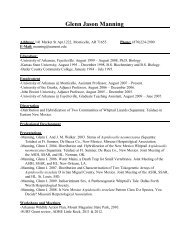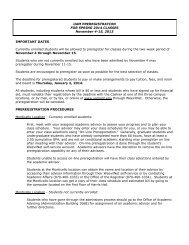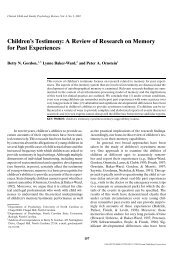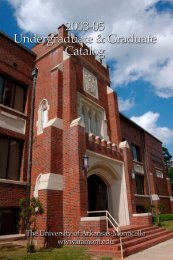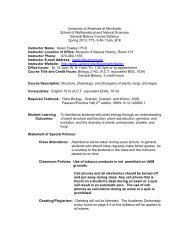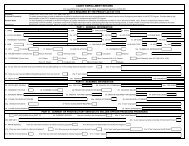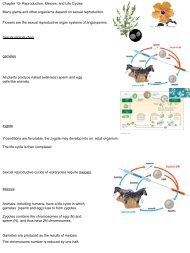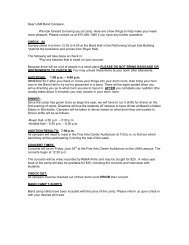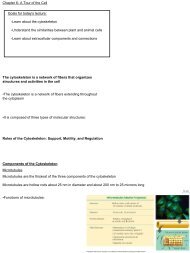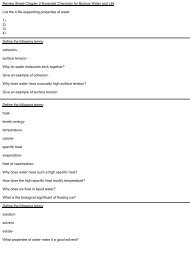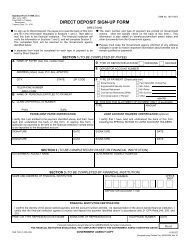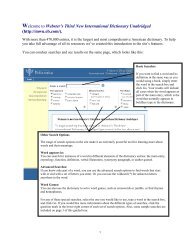A TAAP - University of Arkansas at Monticello
A TAAP - University of Arkansas at Monticello
A TAAP - University of Arkansas at Monticello
You also want an ePaper? Increase the reach of your titles
YUMPU automatically turns print PDFs into web optimized ePapers that Google loves.
Part Points<br />
2 3 points possible<br />
PART II Geometry Released Items––April 2007<br />
1 point: Drawing <strong>of</strong> an equil<strong>at</strong>eral triangle with correct and complete angle measures as<br />
shown below.<br />
Note: The “degree” label is required only for a score <strong>of</strong> 4.<br />
AND<br />
1 point: Correct and complete procedure shown and/or explained finding the measure<br />
<strong>of</strong> the angle <strong>of</strong> the triangle whose vertex is the center point.<br />
Work may contain a calcul<strong>at</strong>ion or copy error.<br />
Give credit for the following or equivalent:<br />
• (All angles about the center point must add to 360º)<br />
x = measure <strong>of</strong> angle <strong>of</strong> triangle whose vertex is the center point<br />
30 + 30 + 30 + 30 + x + x + x + x = 360<br />
120 + 4x = 360<br />
4x = 240<br />
x = 60, or<br />
• 2(30) + 2x = 180<br />
2x = 120<br />
x = 60, or<br />
• “The angles <strong>of</strong> the rhombus and the triangle whose vertex is the center point<br />
make a 90º angle.” (Explan<strong>at</strong>ion <strong>of</strong> why this is true is required for a score <strong>of</strong> 4.)<br />
“So the measure <strong>of</strong> the angle <strong>of</strong> the triangle is 90 – 30 = 60º.”<br />
AND<br />
1 point: St<strong>at</strong>ement or drawing showing th<strong>at</strong> the triangle is isosceles and the base angles<br />
measure 60º (work may be missing).<br />
Work may contain a calcul<strong>at</strong>ion or copy error or may be based on an incorrect<br />
measure <strong>of</strong> the “center angle” (work must be shown to receive credit).<br />
Give credit for the following or equivalent:<br />
• “Because the sides shared with the rhombi are congruent, the triangles are<br />
isosceles. The base angles must be congruent and the sum <strong>of</strong> the angles in the<br />
triangle must be 180°. I subtract 60 from 180 and get 120. Half <strong>of</strong> 120 is 60 for<br />
each base angle,” or<br />
• Diagram shows th<strong>at</strong> 2 sides are <strong>of</strong> the triangle ≅ and the base angles measure<br />
60º (with “center angle” measuring 60º), or<br />
• “The triangle is isosceles. Since the 1 st angle is 60º, I know the base angles are<br />
each 60º since 60 + 60 + 60 = 180, the triangle is equil<strong>at</strong>eral.”<br />
Note: Do not give credit if the response jumps to the conclusion th<strong>at</strong> the<br />
triangle is equil<strong>at</strong>eral (or marks 3 sides ≅ on a diagram) without initially<br />
st<strong>at</strong>ing or showing th<strong>at</strong> 2 sides are ≅ .<br />
Ex: “Measure <strong>of</strong> base angles = 60º since 180/3 = 60”<br />
Ex: “It’s an equil<strong>at</strong>eral triangle so all angles are 60 degrees.”<br />
(Does not initially st<strong>at</strong>e th<strong>at</strong> the triangle is isosceles.)<br />
34



